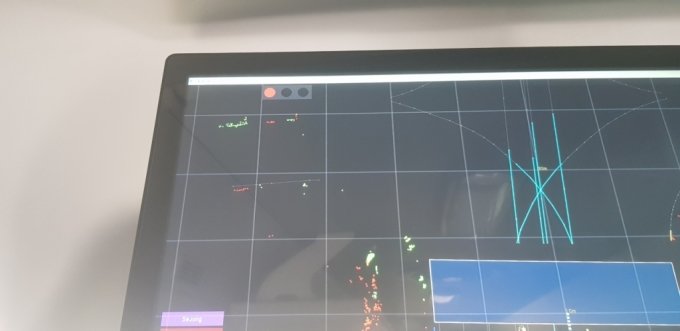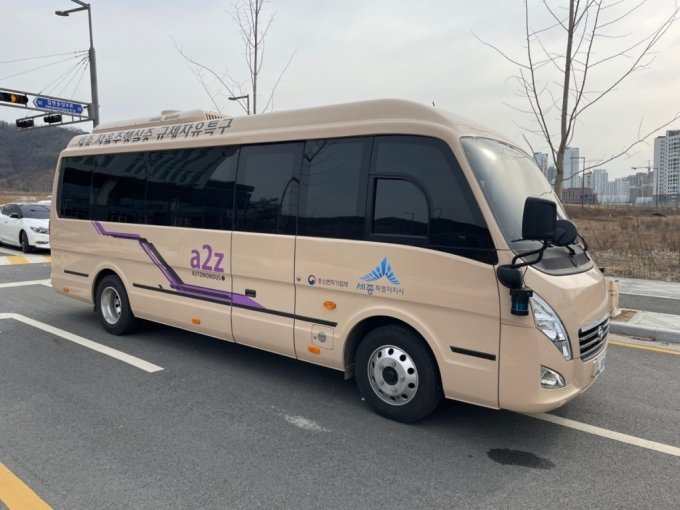Press Buses running at 50 km/h on public roads, the driver put the steering wheel
페이지 정보
작성자 Autonomous a2z 조회 1,606 작성일 2021-03-31본문
It was a general road, not a driving test site or a laboratory. A 15-seater bus started running along the BRT (arterial express bus) road used by Sejong citizens for commuting to and from work. On the screen behind the driver's seat, the surrounding roads and facilities, as well as scattered leaves of boxwood planted along the roadside, were displayed. When the traffic light in front of the crosswalk changed to yellow, the bus started to slow down about 20 meters ahead. The bus started moving again only after sending all those who crossed the crosswalk diagonally from the roadway in addition to those normally crossing the crosswalk. The hands and feet of the person sitting in the driver's seat were free while driving 7km from the Sejong Jiphyeon-dong industry-academia-research cluster to Daepyeong-dong Sejong Bus Terminal.
The autonomous driving bus that the reporter took in Sejong City on the 30th was enough to raise expectations that a bus without a driver's seat would be commercialized soon. The bus, which is being tested by venture company Autonomous a2z in the Sejong autonomous driving zone, has been carrying passengers on the general BRT line since 4 months ago.
After a meeting between the Minister of SMEs and Startups Kwon Chil-seung and officials from companies residing in the Sejong Special District, the self-driving bus was tested. People drove from the entrance of the industrial-academic research cluster building to the BRT line.
Better stability than a human-driven bus

After coming out to the BRT line, when the a2z employee who sat in the driver's seat pressed the button, the car's steering wheel began to vibrate with a start sound. It was a process in which the lidar (laser radar) attached to the front of the vehicle grasped the surrounding road conditions, converted it into an image, and adjusted the direction according to the road line.
The bus started operating and gradually increased its speed and started running at a speed of 50 km/h. Han Ji-hyeong , CEO of a2z, explained, "The self-driving bus is set to obey traffic laws unconditionally, so it does not exceed the speed limit."
The Sejong City BRT Line was located in the center of a six-lane round-trip road like the bus center lane in Seoul. The difference from Seoul is that the central lane and the general vehicle lane are physically separated. Because of the high independence of buses, it is a favorable environment for the commercialization of autonomous buses compared to other cities.
It didn't go out of line even in the dark.

The autonomous driving bus was not disturbed even though it crossed many underpasses in Sejong City. In the case of sensor technology that visualizes images, spatial perception is poor on rainy or foggy days or in dark places such as tunnels. On the other hand, a vehicle equipped with lidar technology can drive without difficulty even in pitch-black darkness.
When a traffic light is visible, the vehicle slows down first and stands close to the stop line. CEO Han Ji-hyeong explained that the vehicle was made for the purpose of carrying passengers and driving it, so it took into consideration the safety of the customer.
Occasionally, the bus stopped at a section where there were no traffic lights. It's right at the bus stop. As this was a test run, we did not actually pick up passengers, but we installed a card reader at the entrance of the vehicle that passengers can pay for and ride with a transportation card.
A sudden stop instead of violating the central line to comply with traffic laws

This autonomous driving bus showed technology that moves along the BRT line, obeys signals, stops while recognizing the stop, and safely responds to unexpected situations. Even in the midst of the actual route buses coming and going back and forth, he performed his duties stably without interfering with traffic.
However, during the Sejong Free Regulation Zone, which ends in August of this year, work to standardize data collected by companies in the special regulation zone to increase reliability, and insufficient manpower pools were cited as common concerns of autonomous driving venture companies.
In response, Minister of SMEs and Startups Kwon Chil-seung said at a meeting on the same day, "The government is paying attention to the special regulation-free zone, but there are many difficulties such as changing the law." I will try my best to make it happen,” he said.


